This coming June 22nd, Jakarta will be five years shy from turning half-a-millennium old. This megacity has come a long way from its humble beginnings when it was still called Sunda Kalapa, a port that was controlled by successive Hindu and Buddhist kingdoms in the western part of Java since the fourth century CE. In the 16th century, the Portuguese arrived at its shores – the first Europeans to do so. They were on their quest to find the fabled Spice Islands from which highly-prized nutmeg and clove originated. The local Sunda Kingdom – among the last Hindu states on Java – which ruled over the port saw an opportunity in this. They forged an alliance with the Portuguese to help them defend Sunda Kalapa from the impending forces of the Demak Sultanate who were on a mission to spread Islam across the island. However, circumstances ended up favoring the latter who then renamed the port Jayakarta in 1527, a date which is now commemorated as the founding of Jakarta.
By the time the English and the Dutch entered the spice race in the region and set their presence in Jayakarta, the port city was already an important trading hub in Southeast Asia. In the early 17th century, officers from the Dutch East India Company (VOC) burned down a fort in the port that belonged to their English archrival – the EIC – and consolidated their power. Subsequently in 1619, the VOC christened the port city Batavia after the Batavians – the name used to refer to the people who had inhabited what is now the Netherlands since pre-Roman times. In the following centuries, Batavia grew further to become a big and bustling city, providing abundant business opportunities which attracted people from all over the Indonesian archipelago and beyond. Some arrived in the city on their own, while others were brought in by the Dutch as slaves or laborers. Many of them ended up staying and marrying local men and women, or fellow outsiders who decided to call Batavia home. Batavia was then renamed Djakarta in 1942, and eventually Jakarta in 1972.
When people move to other countries, they always bring some flavors from back home to their new lands. And when an intermarriage happens, different flavors from both sides are combined resulting in the creation of new dishes. And that is what Betawi food is all about.
In a previous post, I mentioned briefly about how the name Betawi came to be. As an ethnic group, the term Betawi only started to be widely used by the creole people of Batavia to refer to themselves around the late 19th or early 20th centuries, and it wasn’t until 1930 when Betawi was officially listed as a separate group in the population census. The cultures that had the biggest influence on shaping the Betawi identity today were Sundanese, Malay, Javanese, Arab, and Chinese. With sharp eyes, one can notice even their slightest footprints in Betawi culture, whether in the local architecture, traditional costumes, or the dishes.
Speaking of Betawi food, there are dozens of such dishes that originated in Jakarta’s Betawi community, while others may have been introduced from somewhere else which over time were then absorbed by Betawi culture. However, in my opinion originality should not necessarily be the focus when we talk about Betawi cuisine because of the history of Betawi itself as an amalgamation of different cultures. The discussion should otherwise center on how to preserve them, for some of these dishes are increasingly hard to find in the Indonesian capital these days. But isn’t that counterintuitive? Shouldn’t it be easy to find cuisines associated with Jakarta in Jakarta?
Well, not necessarily. When rapid development began in earnest in the city, a lot of Betawi-owned land especially close to the city center were turned into roads, government offices, skyscrapers, and high-rise apartments. Because of this, many Betawi families had to move elsewhere, voluntarily or not. A large number of them decided to restart their lives on the outskirts of Jakarta, although some managed to stay in the city. Over time, more and more people from all over Indonesia came to the nation’s capital and economic hub, a process which often sidelined the Betawi people for they were often seen as less competitive than the newcomers. They’ve become merely spectators, not actors, of their own city’s rapid growth – with a few exceptions. Today, the Betawi make up around 28% of the population of Jakarta, down from 36% in 1930. And if one goes to any Indonesian restaurant in the city, the likeliness of seeing Javanese, Sundanese, Balinese, or West Sumatran dishes on the menu, rather than Betawi food, is generally higher.
After living in this metropolis for almost 14 years, I’ve come to a conclusion that there are three types of Betawi cuisines: those most people know about and are easily found in the city; those many people have heard of but haven’t necessarily tried; and those whose names people are unfamiliar with which will raise the question “what is that?”. However, the classification of dishes in these categories is based purely on my personal experience and does not reflect a general consensus.
Category 1 – The Most Common
Of all dishes often associated with Jakarta, nasi uduk is probably one of the most famous, at least among Indonesians. Although its origin is probably Javanese, nasi uduk vendors can be found all over the Indonesian capital, a fact which helps tie its identity to the city. By itself, nasi uduk is already delicious since it is essentially rice cooked in coconut milk into which aromatics (mainly lemongrass and salam leaves) and spices (typically cloves and cinnamon/cassia bark) are added. But traditionally it is served with a few side dishes that can be any source of protein (chicken and egg are the most common) or more carbs (rice noodles and potatoes) with the addition of all the usual condiments that are present in many Indonesian dishes: kerupuk (traditional crackers), fried shallots, and sambal.
Another popular Betawi dish is gado-gado, and it is arguably one of the most well-known among foreigners due to the fact that it’s usually available at most Indonesian restaurants abroad. One of many vegetable-based dishes from Indonesia, gado-gado typically consists of potato, lettuce, cucumber, beansprouts, cabbage, tofu, tempeh, and hard-boiled egg which are then smothered in a thick sauce made from peanuts (or sometimes cashews), palm sugar, coconut milk, kaffir lime leaves, tamarind juice, garlic, red peppers, and bird’s eye chilies, among other ingredients. However, in my opinion not all gado-gado are created equal. Some are tastier than the others, so therefore knowing where to try it is important.
The last dish in this category is soto Betawi, a local rendition of soto, an Indonesian soupy dish that come in many regional variations. Some soto have clear broth, while others (including soto Betawi) incorporate coconut milk in their recipes. Although in general I like the burst of rich flavors and the taste of umami in a bowl of soto – perfect for cold weather or just to lighten up my mood – there are some I can genuinely call my favorites. Soto Betawi is one of them. The soup is made from a mélange of different spices and aromatics which include cinnamon/cassia bark, cloves, nutmeg, pepper, coriander seeds, ginger, galangal, shallots, garlic, lemongrass, salam leaves, and kaffir lime leaves. All of the ingredients are first stir-fried to release their aroma, then mixed with a beef broth into which coconut milk or normal milk or both is then added. To serve, chopped beef brisket and offal, as well as boiled/steamed potato, sliced tomato, and chopped scallion are added into the soup, then topped with emping (a type of cracker made from melinjo seeds). Pickled cucumber, carrot, and bird’s eye chili, as well as sambal and a slice of jeruk limau (a small-sized citrus widely used in Indonesia) are usually served as condiments.
Category 2 – The Not-So-Elusive
One day when I was on the way to the office during my earliest years living in Jakarta, I stumbled upon a street vendor selling a breakfast dish I wasn’t familiar with. Called nasi ulam, it was plain white rice served with sweet beef jerky, diced cucumber, serundeng (grated coconut sautéed with spices), and kemangi (Indonesian basil) which together gave the dish a very pleasant aroma. However, it took me many years to eventually try this dish again, for it is not as widely available as nasi uduk despite its easier preparation. Recently, after looking for information about the best places to have authentic nasi ulam in Jakarta, I learned that there is actually one that is not too far from where I live. Tucked away in one of Jakarta’s kampung (a low-rise, dense neighborhood with close-knit communities that resemble those in villages or small towns), and just a short walk away from the skyscraper-studded central business district, is a hole in the wall that has been serving Betawi dishes for generations (it started in another place in the early 1950s). The portion was generous and I decided to have it with a fried chicken and telur balado (hard-boiled egg in chili sauce) on top of the usual condiments. I found it even more flavorful and fragrant than the one I had more than a decade ago, thanks to the copious amount of serundeng mixed with fried shallot as well as the sambal kacang (sambal made with ground peanuts) that came with it.
While it takes a little effort to have nasi ulam in Jakarta, there’s another dish that is probably more emblematic of the city but easier to find, only if you look for it at the right time. Kerak telor, literally “egg crust”, is one of the Betawi specialties that are always present during Jakarta’s anniversary. But when the celebration is over, also gone are most of the kerak telor vendors. Those who remain open all year round are usually the ones that have been in business for decades, selling this “Betawi pizza” whether there’s a festivity or not. When you do happen to find a kerak telor vendor, make sure to watch how the snack is prepared as opposed to just waiting for it to be served to you, and opt for the duck egg as it has a richer taste than chicken egg. The entire cooking process is a spectacle in itself, for it involves the person behind the small wok turning the metal vessel upside down halfway through to cook both sides of the sticky rice ‘pancake’. The finished product is a golden brown, omelet-like delicacy sprinkled with fried shallot and serundeng, and sliced in the way a pizza would.
Another famous classic Betawi dish is semur jengkol. It’s arguably easier to find than nasi ulam or kerak telor, but it is almost exclusively served at modest, street-side eateries – not at malls or hotels – for one reason: its high sulfur content is so potent it produces, to put it mildly, an unpleasant smell during one’s daily routine in the toilet the next morning. But apart from the after-effects, semur jengkol is actually quite tasty. Its texture is similar to that of a boiled potato but with a slightly mushroom-y bite. And the sauce in which it’s cooked is made of spices and aromatics with kecap manis (Indonesian sweet soy sauce) to give it a sweet and umami flavor and a distinct dark color. A scene from a popular Indonesian soap in the 1990s about a young Betawi man illustrates how much Betawi people hold semur jengkol dear. When the main protagonist gets an opportunity to go to Switzerland for work, his doting mother tells him she will make semur jengkol for him to bring – which of course he doesn’t.
While I put gado-gado in the previous category, there’s another salad-like dish from Jakarta that in my opinion falls into the second category: asinan sayur. Its main ingredients are sliced cucumber, chopped cabbage, beansprouts, lettuce, and tofu that are served in a red sauce made from ground fried peanuts, cabai keriting (a type of long and thin red chili cultivar popular in Indonesia), palm sugar treacle, cuka (Indonesian vinegar), and salt. Right before it’s served, yellow and red Betawi-style crackers are added as toppings. While some of the components that make up asinan sayur sound similar with the ones in gado-gado, one of the main differences between the two is that the vegetables in the former are always raw, unlike the boiled ones used in the latter. But both are the same in a way that despite their initial impression as light dishes, they can actually be quite filling.
Category 3 – The Rarest
Now let’s talk about the rare ones, so much so that many people – even some of those who have been living in Jakarta for a long time – have never heard of these names or only have a vague idea of what they are. In a blog post from last year, I wrote about laksa Betawi, a local rendition of a soupy dish popular in parts of Southeast Asia. It’s not hard to imagine people loving this dish for its rich and satisfying flavors. However, strangely there are not many places that serve it, making this visually-appetizing Betawi specialty a rather elusive dish. To make matter worse, one of the few places in the city specializing in laksa Betawi seems to have closed down forever, a sad situation I only learned earlier this year when I went there to try their sate Betawi – an even rarer Betawi dish. “We only make them for special orders now,” a man explained to me and James as we arrived at the quiet place that has now been turned into a kiosk selling snacks and beverages.
We had better luck in our search of bubur ase, a Betawi take on the Chinese-influenced congee that has been transformed into bubur ayam (literally “chicken congee”), a much-loved breakfast dish with dozens of variations across Indonesia. The main difference between the latter and its Betawi counterpart, apart from the absence of ayam (chicken) in bubur ase, is in the ingredients used. The Betawi congee has pickled cucumber, asinan sayur, and beansprouts over which sweet semur soup with tofu and beef is then poured. Red Betawi-style crackers, emping, and fried peanuts are then added on top of everything before the dish is served. I grew up eating bubur ayam and love it for the combination of savory and umami taste with smooth texture that never fails to comfort my palate. That’s why when I first found out about bubur ase, I was both a little apprehensive (due to the sour taste from the asinan sayur) and curious. Luckily, my curiosity won so I decided to give it a try at a modest street-side food cart in Central Jakarta. When the first spoonful of bubur ase entered my mouth, I was confused for a brief moment, but then I soon realized that the flavor combination of all the ingredients actually worked. It truly was a revelation, but sadly the place we went to is among the last remaining bubur ase vendors in Jakarta.
While laksa Betawi and bubur ase incorporate ingredients most Jakartans are familiar with, sayur besan is on the other end of the spectrum. It’s rare mainly because one of the key components of the dish has become harder to find at traditional markets in Jakarta these days. Terubuk, also called tebu telur (literally “egg sugar cane”), is a plant that is related to the common sugar cane but is sought after for its tips or unopened buds that conceal the real treasure within. With a shape and color that resemble cylindrical tofu, this part of terubuk is what people use to make sayur besan, a Betawi dish traditionally served at weddings. (The word besan itself means in-laws, so when your child is getting married, the parents of your child’s spouse will be your besan – and you are theirs.) Many people liken the texture of this part of terubuk with that of the roe of terubuk fish (Tenualosa toli), hence the name. I personally have never tried the roe of this saltwater species, but in a way it did remind me of the roe of belanak (Crenemugil seheli, also known as the blue-spot mullet), a delicacy I used to eat as a child in Borneo.
Another rare dish I believe shouldn’t be this hard to find is gorengan kambing, fried goat meat served in a rich and aromatic soup into which gulati and emping are added. What really baffles me about this particular delicacy is the fact that the ingredients are actually quite common. Except for fenugreek which is needed to make gulati (in addition to cumin, ginger, galangal, nutmeg, garlic, and shallot to make this stir-fried green bean dish which is a key component of gorengan kambing), everything else is something most Indonesian cooks use every day in their kitchens. I have yet to find the answer as to why there are only a few people in Jakarta who seem to know about this and make it.
If sayur besan and gorengan kambing prove to be too elusive, pecak gurame is another Betawi dish that falls into the same category but is considerably easier to find. In general there are two types of it: one with a clear soup, and the other one with a peanut-and-candlenut sauce. In both variants, giant gourami (Osphronemus gouramy) is first fried before being smothered in the sauce/soup. On the clear soup side, one version of it has the distinct taste of fingerroot – a spice with which my mother makes her spinach stew – which is quite different from the emphasis on turmeric in the other version. On the other hand, the sauce for the second variety of pecak gurame is made from peanuts and candlenuts (to replace the more expensive cashews from the original recipe), red chilies, bird’s eye chilies, shallots, garlic, turmeric, sand ginger, and coconut milk. Special journeys to the far southwest corner of Jakarta as well as a place in East Jakarta were needed to try the former, but to have the peanut-based version, we went farther to the south of Jakarta near Setu Babakan – an area dedicated to preserving Betawi culture – to go to Rumah Makan H. Nasun, arguably the best place to have that particular kind of pecak gurame.
As a matter of fact, the very same restaurant is also known for another Betawi dish: gabus pucung. This delicacy is made from gabus fish (Channa striata) or snakehead murrel in English and pucung – the fermented seed of Pangium edule (which is highly poisonous in its raw form) also known as kluwek, keluak, kepahiang, and pammarrasan in other parts of Indonesia. The unique ingredient gives the dish its distinctive black color and earthy flavor, and is combined with many of the usual spices used in Indonesian cooking to create gabus pucung. While this dish isn’t necessarily the hardest to find, the reason why it falls into the third category is because it’s rarely available at Rumah Makan H. Nasun – reportedly the best place to have gabus pucung. On my first visit, they didn’t have it. And since then, every time I asked them via WhatsApp, they always said they couldn’t find the gabus they wanted at the market. I suppose it’s more because they have specific criteria for the fish which makes their version of gabus pucung stand out among others. In the end, I decided to go to another Betawi restaurant to have this dish, which turned out to be quite good but a little too salty for my liking.
(UPDATE: One hour after I published this post, Rumah Makan H. Nasun informed me via WhatsApp that they had gabus pucung. I immediately took the commuter train to get there and had their famous but notoriously rare gabus pucung for an early lunch. Oh my! The dish really lived up to its reputation. It was rich, spicy, but well-balanced with a hint of citrus — probably from kaffir lime leaves. And the fish itself was big and meaty. I have updated the post with a photo of this dish.)
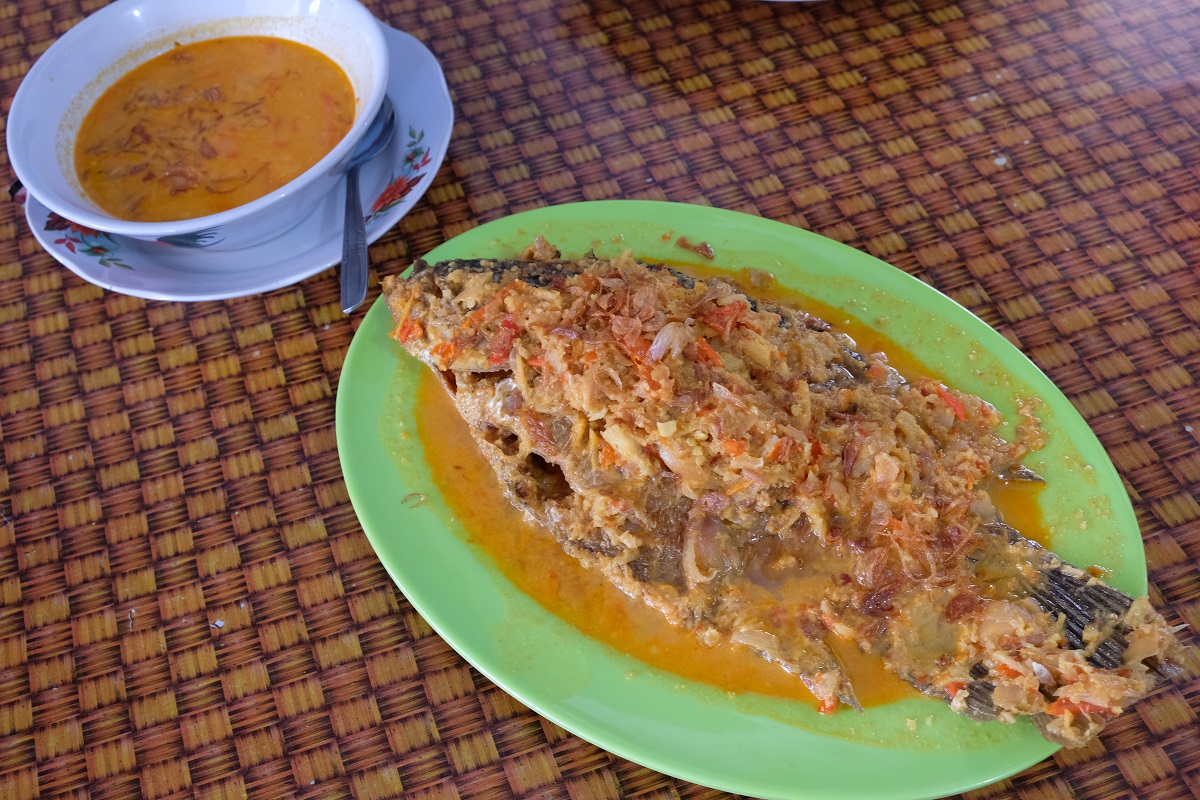
Another version of pecak gurame with peanut-and-candlenut sauce (at Rumah Makan Betawi H. Nasun, since the early 1980s)
Betawi cuisine is undoubtedly dominated by savory dishes. However, it also has a few sweet drinks and desserts which curiously are not easy to find in Jakarta. When beer was brought by the Europeans to Batavia in the past, the predominantly Muslim locals tried to replicate it and create a completely new drink sans alcohol with a color that resembles a dark ale. Using traditional ingredients including ginger, cinnamon, nutmeg, and secang bark (which gives the drink its dark red color), bir pletok was born. Today a handful of small-scale businesses still make it, with recipes that vary greatly from one place to another. My favorite, however, is one that tastes less gingery.
While bir pletok was inspired by beer, es selendang mayang is a Betawi dessert with apparent traces of Chinese influence. Usually served in a bowl, it consists of slices of three-colored cake (typically made from rice flour or mung bean flour) in light coconut milk with palm sugar syrup. Ice cubes are usually added before serving. While making it doesn’t sound overly complicated, finding it in Jakarta proves to be rather hard. By now, you will probably have noticed a recurring theme of how difficult it is to find many Betawi dishes in Jakarta, which is ironic given their origins in the community that was born in this city.
Most of the restaurants, food joints, and modest stalls where I tried some of the best Betawi dishes have been running their businesses for decades. Quite a few of them are still doing well, while others are struggling to survive – that sate Betawi place even closed its doors before I got the chance to try it. While it is encouraging to see more and more Betawi dishes making their way onto the menus of popular Indonesian restaurants in the city, this represents only a fraction of the entirety of Betawi culinary traditions.
Food is one of the most exciting and fascinating aspects of human civilization, for it provides a window into different communities and past interactions among cultures that resulted in a wide array of culinary creations. The disappearance of a dish is akin to the vanishing of a fragment of a culture. I believe there is still time to save many rare Betawi dishes so that decades from now people can still savor the flavors of gabus pucung, pecak gurame, bubur ase, nasi ulam, kerak telor, es selendang mayang, and their other Betawi cousins. There is still time.

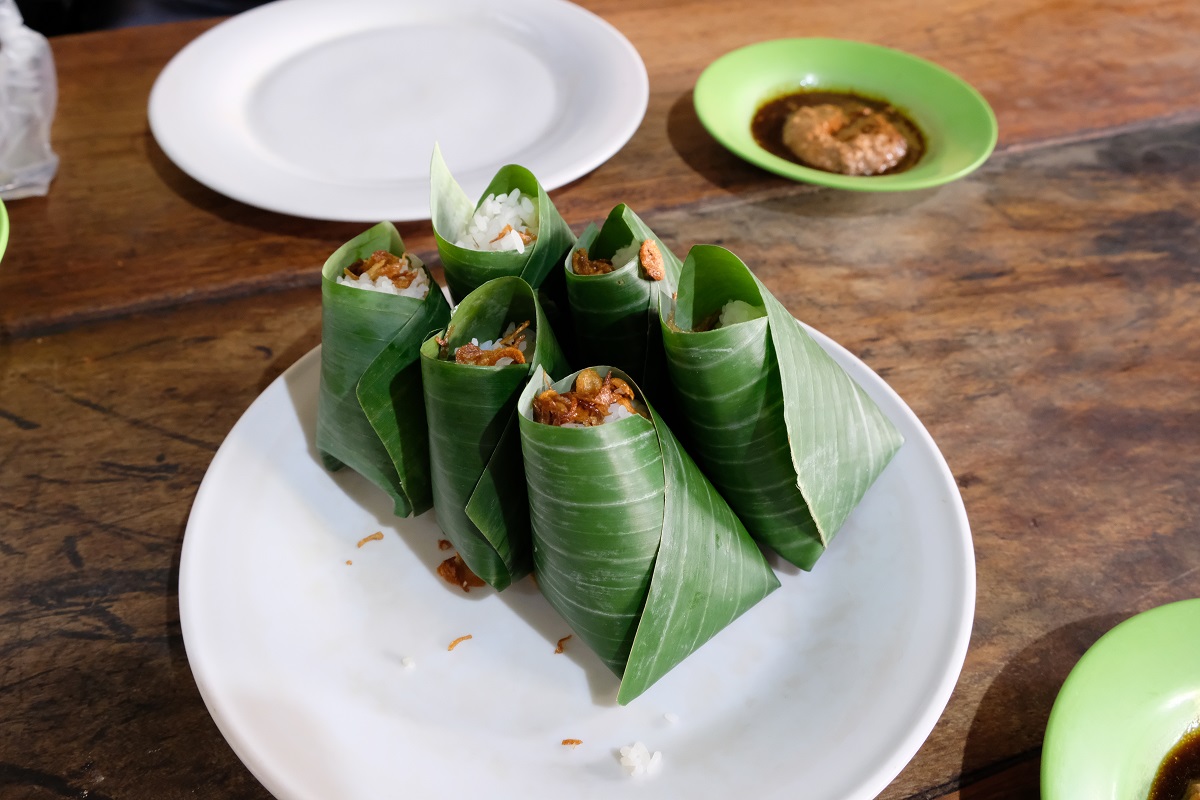


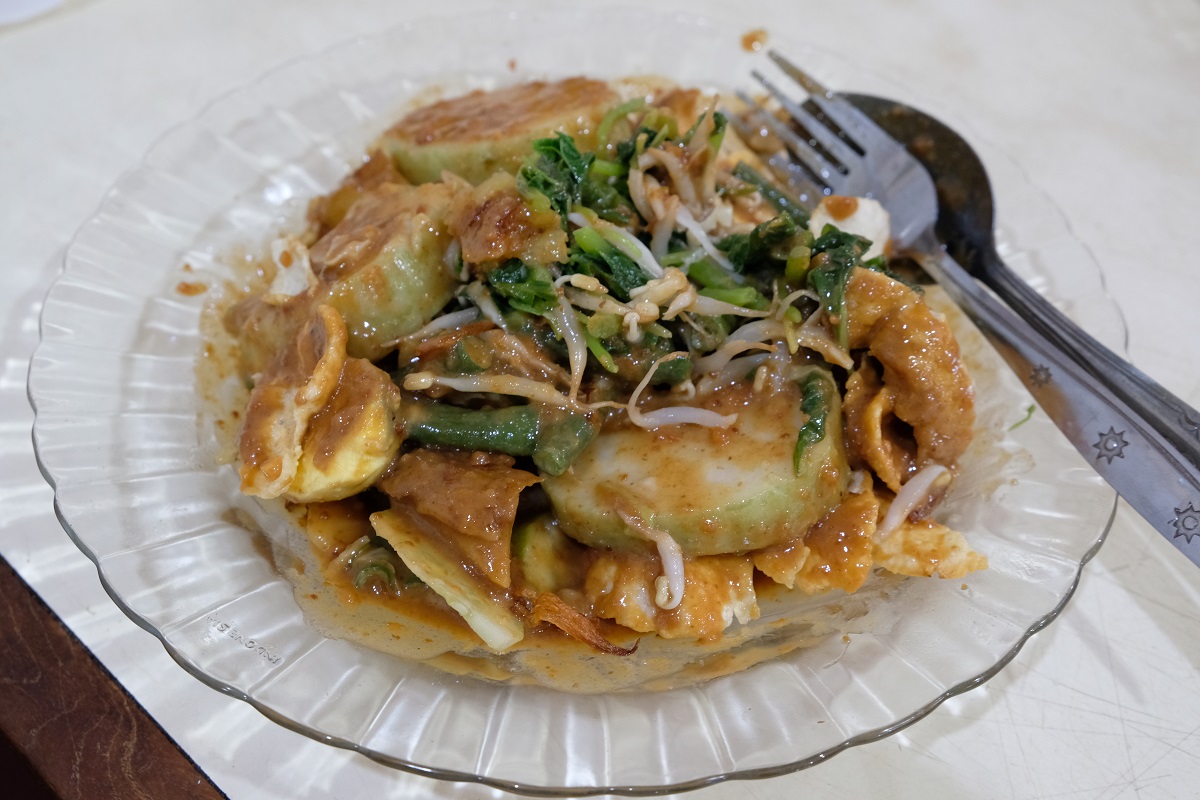


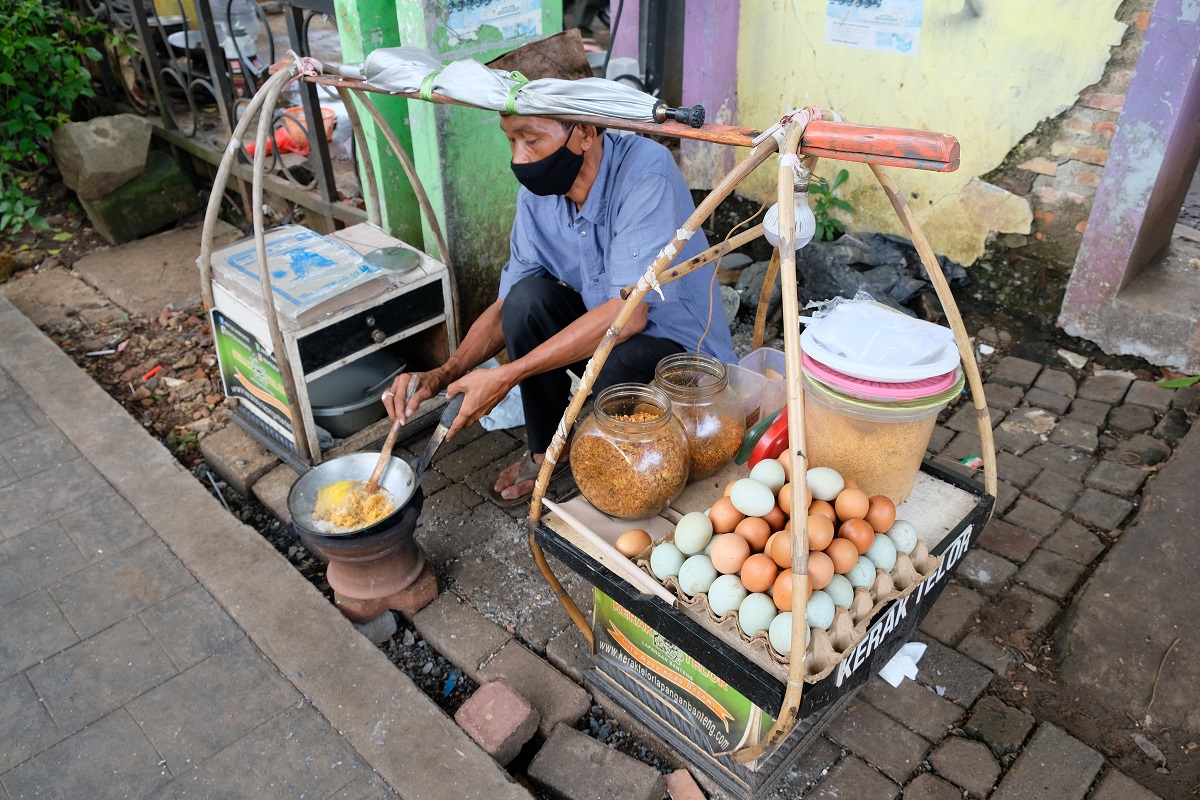

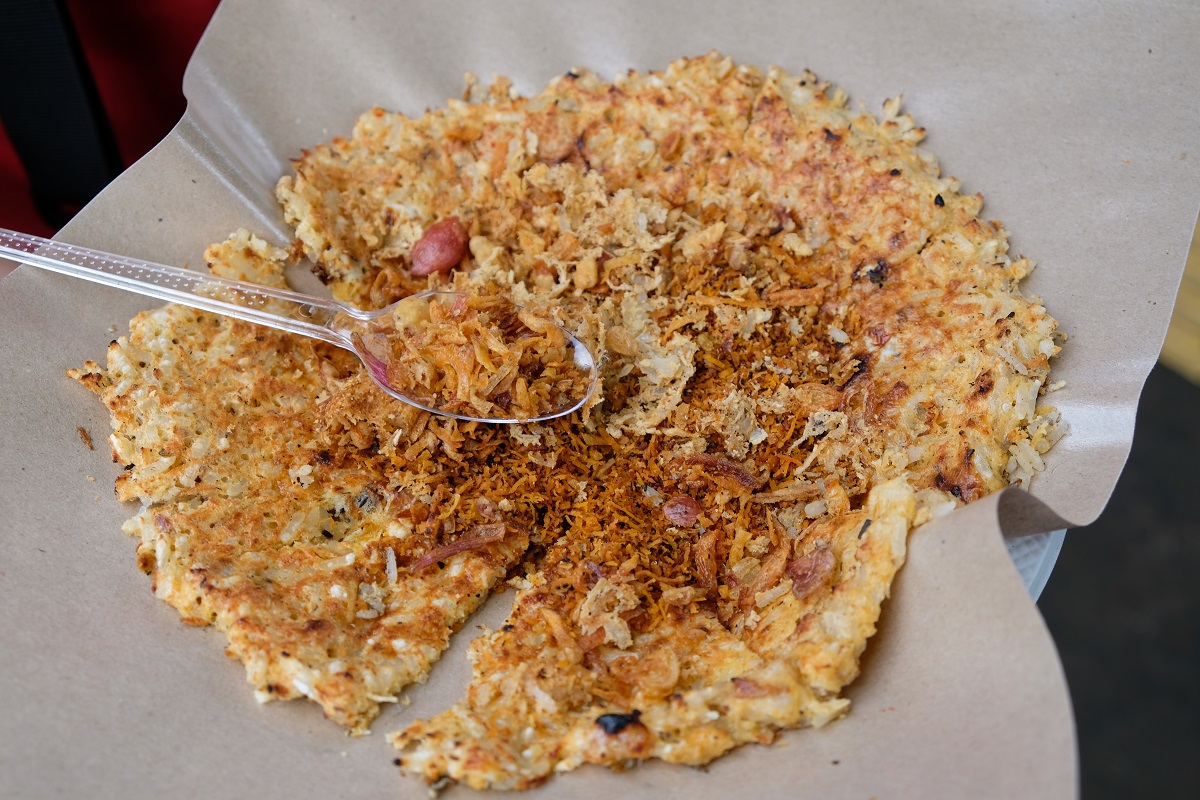
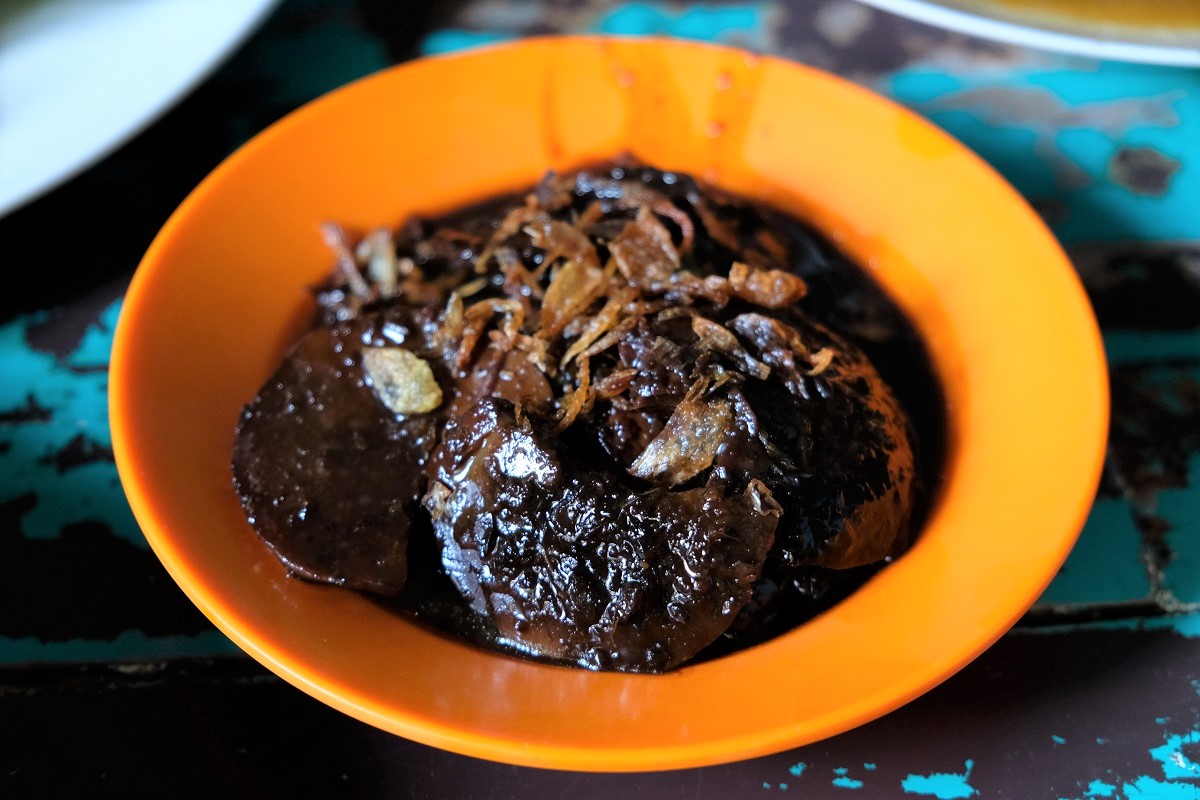
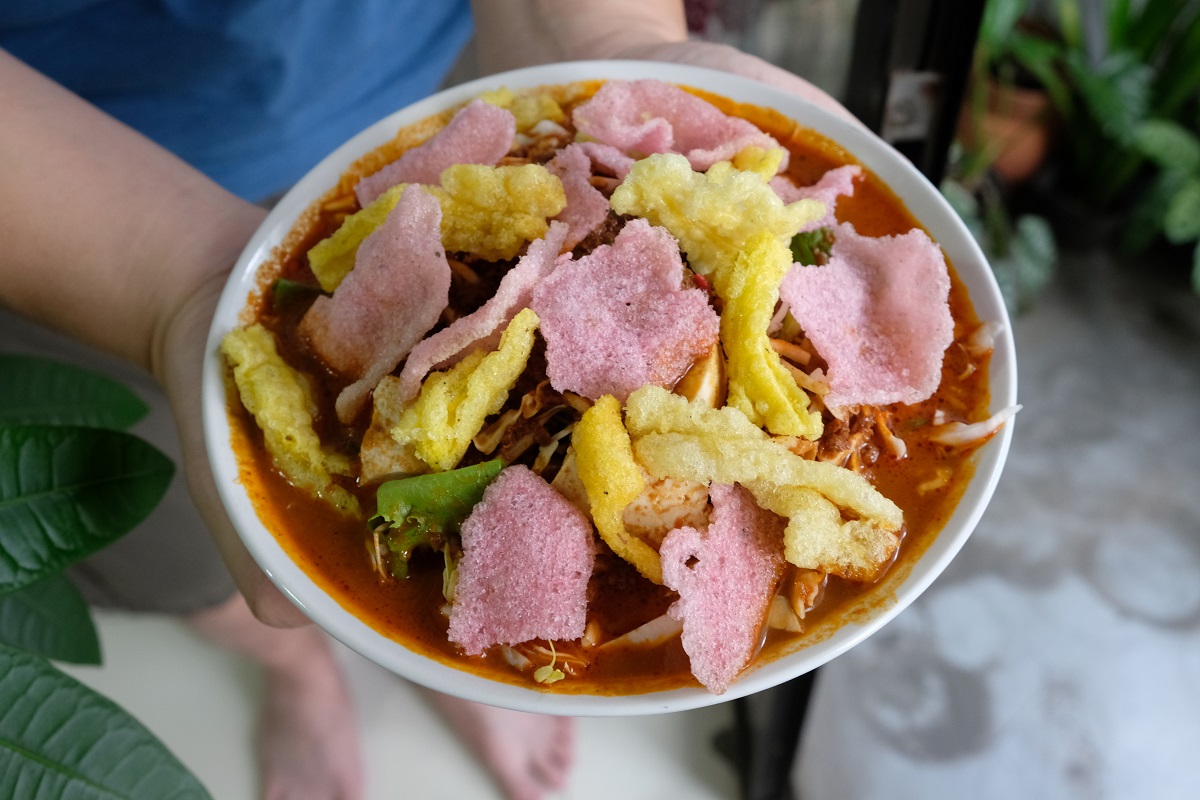


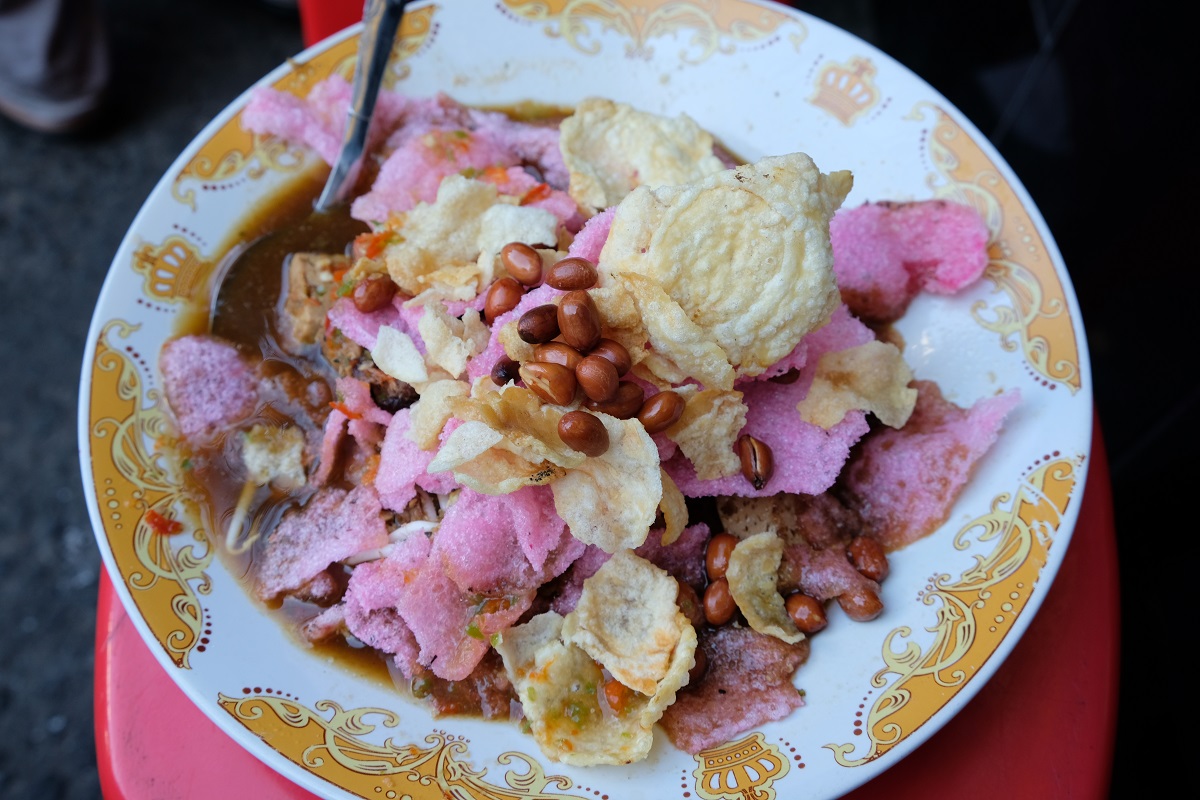



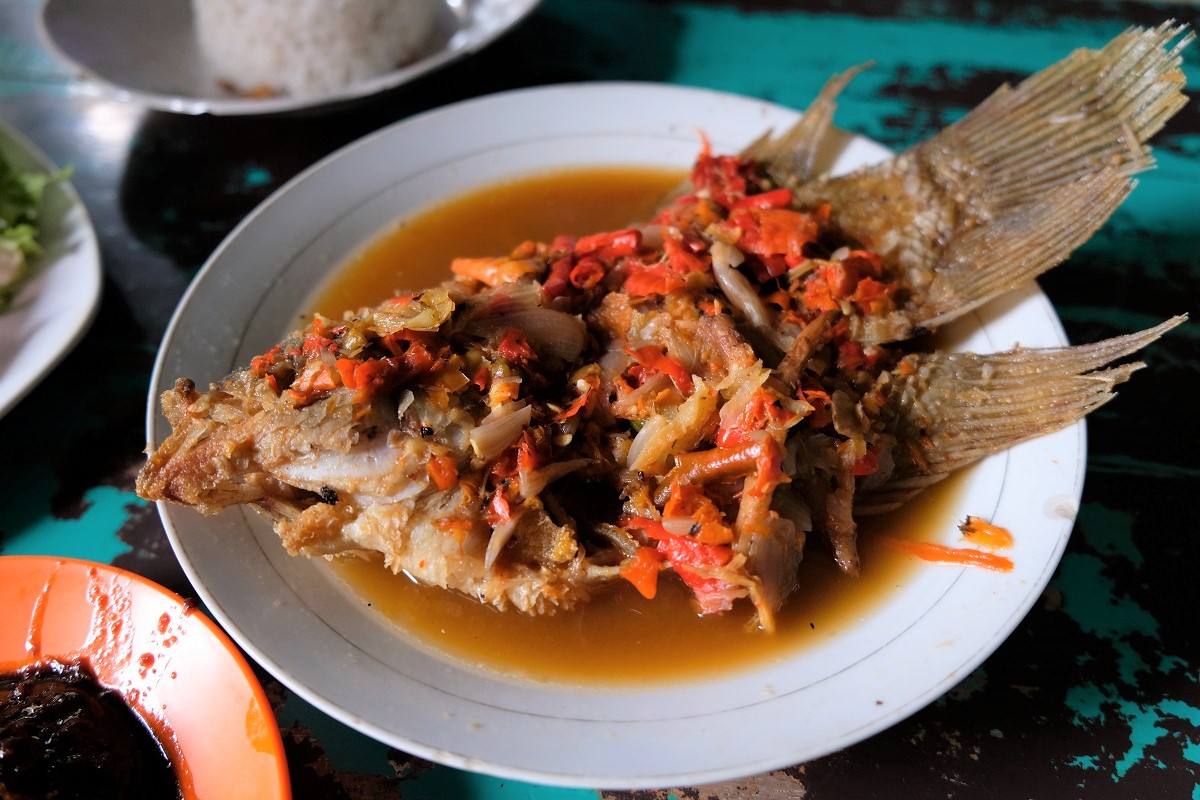
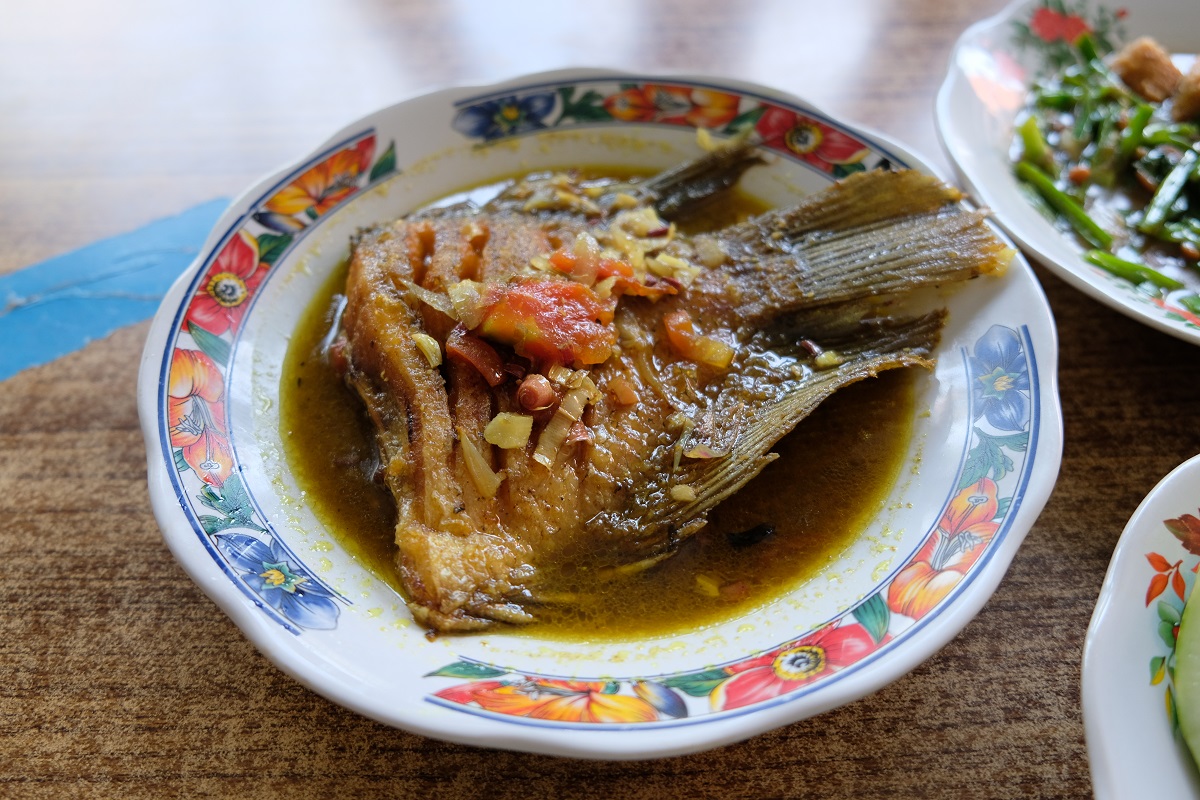

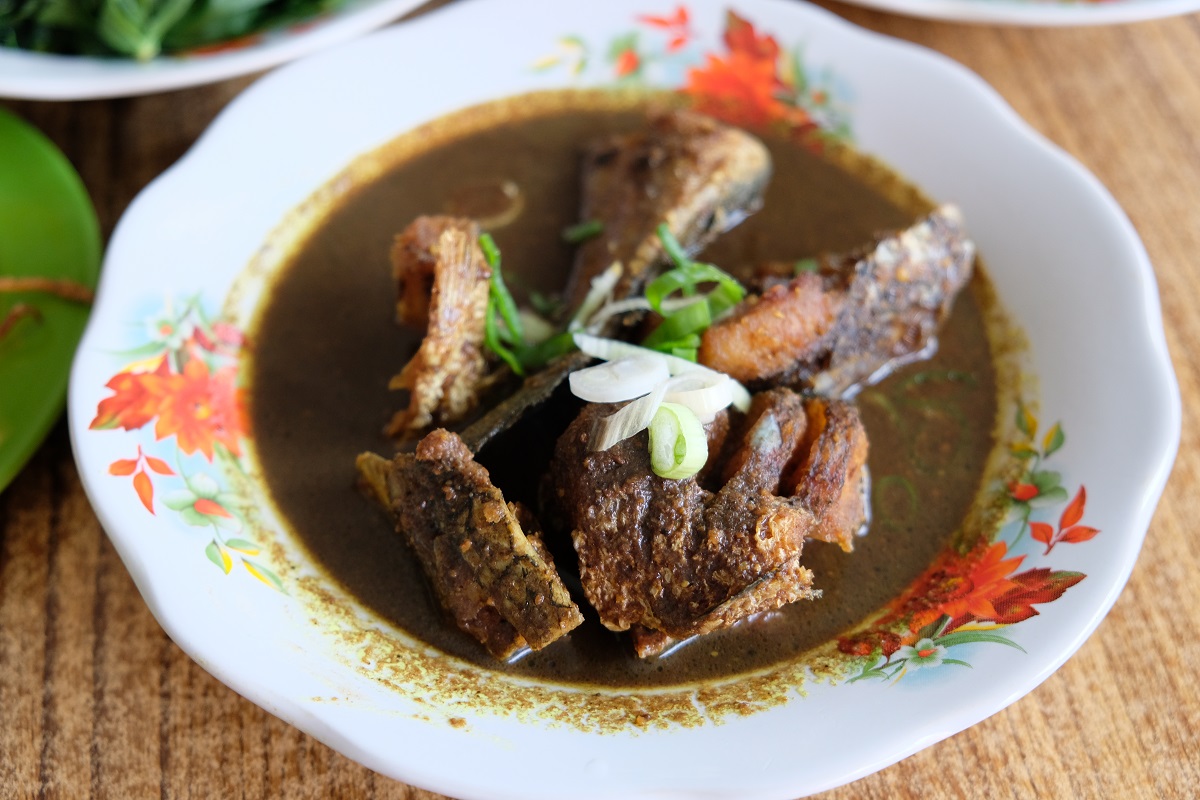
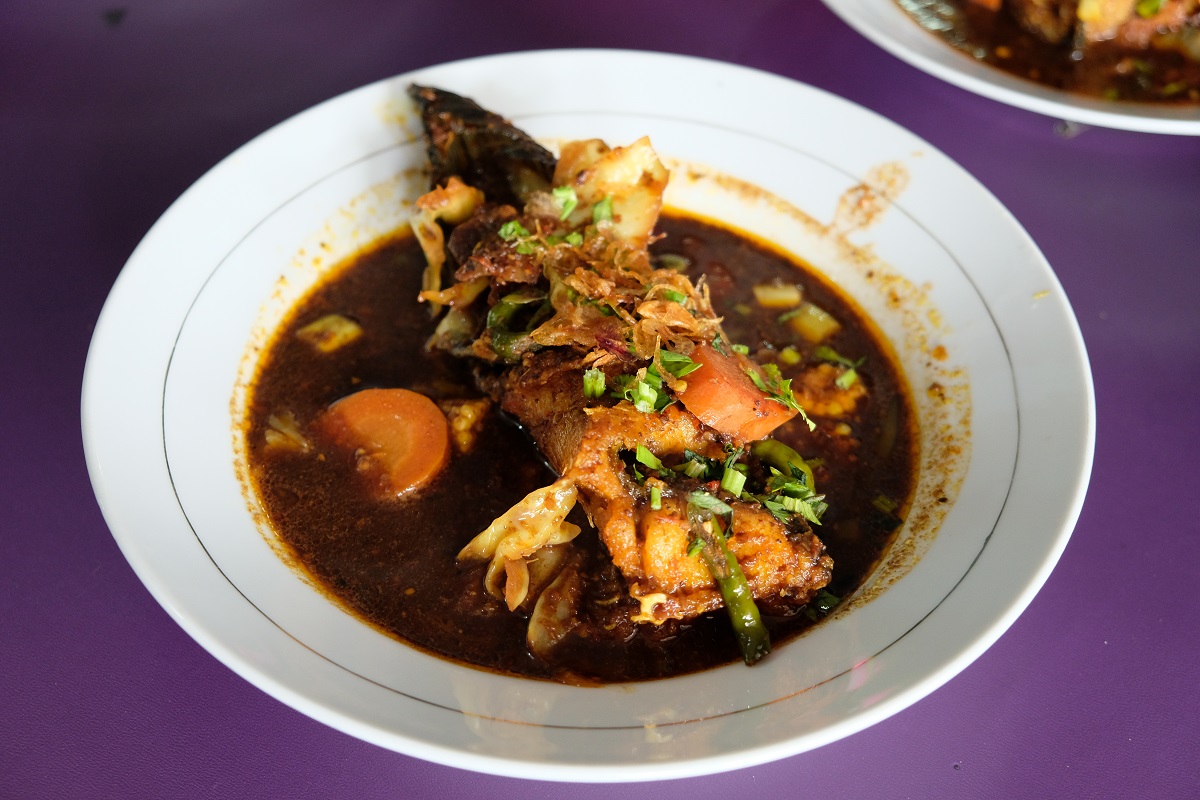
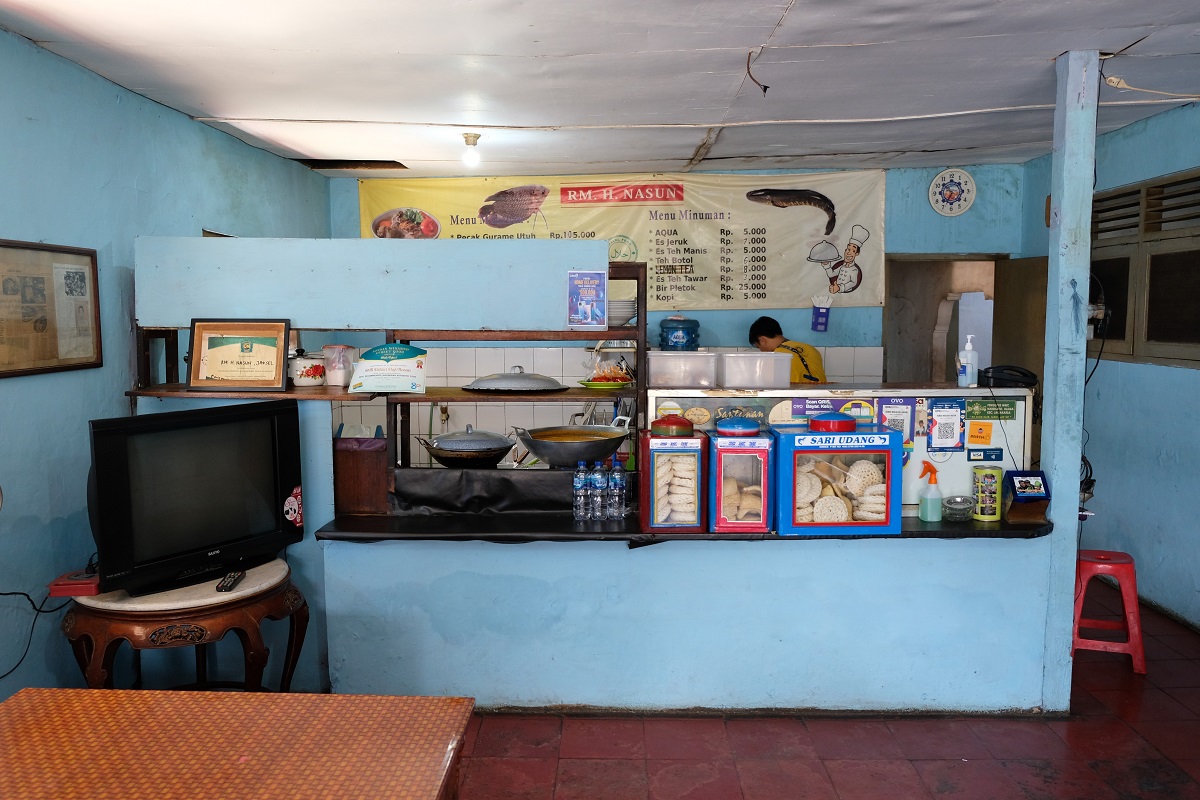


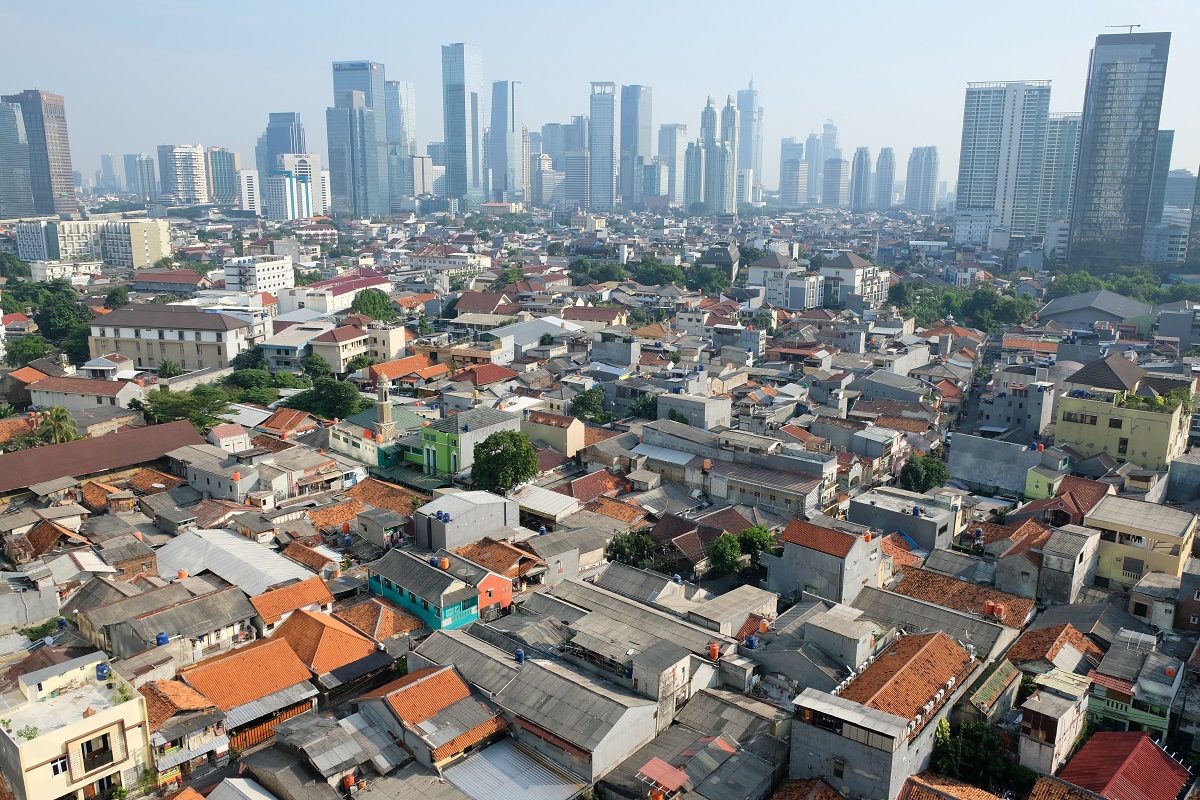
Boy am I glad I had a full dinner before I read your post. The food and photos look and sound mouth wateringly delicious.
Variety really is the spice in life. Pepper and salt usually do the trick for me but I am thankful to have been exposed to using more Asian spices and also chilies over the recent pandemic cooking adventures and it’s really opened up the possibilities. So I can understand the European spice wars.
I’ve never heard of Betaki culture before so it was interesting to learn about them and the influences from different cultures including Hindi and Chinese. I can see them reflected in the food.
I love a good old chicken congee and the Betaki version sounds wonderful. As do the coconut milk-cooked rice wrapped in leaf and topped with friend shallots.
I will definitely have to check out the Indonesian restaurants in our city to see if I can find some of these dishes over here in Canada.
495 years is a long life for a city and you can definitely see all the different generations of influences in its culture and cuisine.
LikeLiked by 2 people
PS. Betawi not Betaki, sorry! Stupid autocorrect on my phone. 😑
LikeLiked by 2 people
No worries, Ab! 😂
I’m glad you read this on a full stomach so I don’t feel too guilty. 😁
Like you, when I cook dishes for myself, I prefer those that are easier and faster to make. However, my adult self has certainly appreciated all the spices used in Asian cooking, for they change something ordinary into dishes that are surprising, exciting, and intriguing.
I really hope you can find Indonesian restaurants there (or somewhere in Canada), and when you do, please let me know what’s on the menu. I know there are Indonesian restaurants in the US that have to swap a few ingredients for things that are easier to find over there.
LikeLiked by 1 person
Spices and sauces definitely go a long in transforming a dish.
Will definitely let you know when I see good Indonesian fare in our city. We have so many great varieties in food in Our city. Just need time to explore them all! Maybe a future post. 🙂
LikeLiked by 1 person
Look forward to that post! 😃
LikeLiked by 1 person
Wow that looks amazing.
LikeLiked by 1 person
They certainly do. I hope you’ll get to try some of these dishes one day.
LikeLiked by 1 person
Excellent Post
LikeLiked by 1 person
Thank you!
LikeLike
Happy anniversary to Jakarta. Wow, I always marvel at the layers of history and the stories it contains in places that are so old, and you always manage to transport me with your vivid descriptions and photos. In my imagination I will have some kerak telor – it looks delicious. I love Indonesian flavours, and my mouth is literally watering just reading this post, Bama. I love how you go the extra mile to discover the cultural nuances and tastes.
LikeLiked by 1 person
It took me years to finally do this Betawi food exploration, and I was surprised to find out many dishes I didn’t know existed. This reminds me sometimes we really have to make the effort to know our cities better. Kerak telor really is a good start for anyone who wants to taste Betawi cuisine, for there’s nothing too foreign in the ingredients. Hope you’ll get to try it one day, Jolandi!
LikeLike
Fantastic post! 🙂 The dishes you posted here definitely remind me of those my late mom tried out when she visited Jakarta more than a decade ago. (The nasi ulam and kerak telor look delectable!)
LikeLiked by 1 person
Thank you, Monch! I wonder if your mom went to some of the places I mentioned in this post when she was in Jakarta. I hope you can find nasi ulam when you come across an Indonesian restaurant somewhere out there.
LikeLiked by 1 person
I don’t know if you allow links here, but I wrote about her 2011 trip — and her discoveries — early this year: https://themonchingsguide.wordpress.com/2022/03/27/317-on-moms-indonesian-foodtrip-circa-2011/
Most Indonesian restaurants here in Manila often have the common dishes you mentioned, but I do hope I find that particular one.
LikeLiked by 1 person
I just read your post and it was really nice that she got to try all those dishes during her visit to Jakarta.
Unfortunately, Filipino restaurant is really hard to find here in Jakarta. I think there is one on the outskirts of the city, but I haven’t been there.
LikeLiked by 1 person
Thank you for sharing your take on the post! It’s rather surprising that despite the proximity of the Philippines to Indonesia, Filipino restaurants are sparse there.
LikeLiked by 1 person
And this needs to change. 🙂
LikeLiked by 1 person
Definitely! Hoping more Filipino joints open on your side of the world soon! 😀
LikeLiked by 1 person
Your post is really a jewel, not only as far as the tempting dishes are concerned, but also concerning historical events!:) Many thanks
LikeLiked by 1 person
Much appreciated, Martina. I just thought it was the right thing to do to include a little background story of how the Betawi came to be.
LikeLike
:):)
LikeLiked by 1 person
I love Indonesian food with its mix of rich spices, nuts and flavours, but haven’t heard of most of these dishes. We have a small Indonesian restaurant not far from us but it includes the typical gado-gado, nasi goring meals, still it is a great treat for us. Next time we travel there I’ll most likely avoid semur jengkol though, thanks for the warning. 😊 Maggie
LikeLiked by 1 person
I’m impressed that Indonesian restaurant near where you live have semur jengkol. I wouldn’t have thought this Southeast Asia-native bean would make it as far away as Canada! But exactly because of that, why don’t you try at least one piece of jengkol? 😄
LikeLike
No I meant I would try it when I get back to Indonesia, sorry that wasn’t clear. The restaurant here has the standard meals, but very well done.
LikeLiked by 1 person
Oops! Sorry, my bad.
LikeLike
Hands down, my choice would be kerak telor! The nasi uduk would be another option because I am a very picky eater, and both of these seem pretty basic! The smelly dish would not pass my lips! Interesting history of Batavia/Jakarta, too; I always learn so much from your posts.
LikeLiked by 1 person
It seems like kerak telor is everyone’s favorite. I will surely take you to that place where I had this dish when you come to Jakarta — its location happens to be near some of the most interesting places to see in the city. (But I will also take you to other places to try some other dishes 😁.)
LikeLiked by 1 person
Nice post and you are making me hungry again 😋 I would love to try the laksa and compare it to the version we have in Singapore.
LikeLiked by 1 person
Haha. I hope you were not on an empty stomach when you read this, Edwin. I would say Singapore laksa is more creamy, while the Betawi version is more spicy and savory. Both have distinct prawn/shrimp taste, but the latter use lontong instead of noodles.
LikeLiked by 2 people
I wonder if you tried Penang laksa which uses assam and tastes completely different from the Singapore or Nonya version. Also, in Northern Thailand Khao soi is something like laksa but slightly different.
LikeLiked by 1 person
I did try assam laksa when I went to Penang, but I have to admit it wasn’t my favorite because of the strong sourness. However, this was seven years ago. As my palate keeps evolving, gradually adjusting to new flavors, I actually don’t mind giving this dish another try. I haven’t tried khao soi, but I’ve had something similar in Myanmar called ohn no khao shwe. Now you’ve got me intrigued!
LikeLiked by 1 person
I’ve never tried ohn no khao shwe, but I’ve tried and love mohinga. It’s kinda like comfort food to me.
LikeLiked by 1 person
Oh I love that dish as well! The one I had in Mandalay (near the former royal palace) is hands down the best mohinga I’ve ever tasted. If only there was a Burmese restaurant here in Jakarta.
LikeLiked by 1 person
as an Indonesian who often goes to Jakarta, the rare foods are really my first time hearing about the food. Gonna try the food when I have time go to Jakarta!!
LikeLiked by 1 person
If you happen to stay in the central part of Jakarta, I really recommend Bubur Ase Bang Lopi in Kebon Kacang area. Come early, though, because it seemed quite popular when I went there.
LikeLiked by 1 person
Thank you Bama for your recomendation.
LikeLiked by 1 person
My pleasure, Ira!
LikeLike
My mouth is watering from all this delicious looking food. That’s quite the commitment to sample many of the common to rare Betawi dishes. You know what they say, the way to a person’s heart is through their stomach 🙂
LikeLiked by 1 person
After calling Jakarta home for almost 14 years, this exploration of Betawi cuisine is essentially a commitment long overdue. 😁 Oh I so agree with that saying. I even have a close friend who loves food so much her lunch can make or break her day.
LikeLiked by 1 person
I agree with you on food Bama, I think you can tell a lot about a culture’s history based on their favorite local dishes. This is my first time hearing about Betawi cuisine, I’m sure these dishes taste as delicious as you describe them. It would be a shame not to preserve these dishes, I think the key is to expose younger generations to these dishes and teach them the importance of preserving them. By the way, I love all your posts about food, you describe the dishes so well that I would like to try them all!
LikeLiked by 1 person
That’s so true, Liz. One example of that is Javanese people’s preference for sweet dishes. It was only a few years ago when I learned that this was partially attributed to the abundance of Dutch-owned sugar plantations on the central and eastern parts of Java when Indonesia was still a colony of the European nation.
Back to Betawi food, you’re right about the importance of young generations knowing these dishes, especially the rare ones. In the end, they will be the ones passing down the recipes of Betawi cuisine to future generations.
Much appreciated, Liz! I hope you can find an Indonesian restaurant near where you live.
LikeLiked by 1 person
What a mouth watering post!
LikeLiked by 1 person
Thanks Mallee! I wonder if you tried any of these dishes in your past travels to Indonesia.
LikeLike
No, I haven’t. I think I’ll try to find some recipes on line that you’ve mentioned when I get back home. I’m in Nova Scotia at the moment where the food is bland, but the seafood is fresh.
LikeLiked by 1 person
I can imagine how fresh the seafood is in Nova Scotia. All you need is a little salt (and maybe pepper and butter), and voilà! A simple, produce-driven dish is served.
LikeLiked by 1 person
Oh bama im positively salivating and looking forward to returning to indonesia hopefully nxt year! My taste buds so excited by your excellent food portraits. .if there could be a favourite it would be the laksa, the snack 😋 and urap . Im going to save this to study makasih 😊🌳🌳🌳
LikeLiked by 1 person
Sama-sama, Trees. Fingers crossed there won’t be any further disruptions to international travel so you can go back to Indonesia! You definitely have to try that laksa. It’s one of my favorite Betawi dishes.
LikeLike
🙏💚🌳
LikeLiked by 1 person
I’m not much of a foodie but this is an excellent post with so much detailing and great descriptions, complete with ample amount of history and background information. Like Betawi dishes many indigenous food from various cultures across the globe are under the threat of disappearing, guess part of the price we pay for globalization. That makes your post quite precious with all the valuable information. I’m sure many local people would learn about some of the rare dishes for the first time. The description of nasi uduk is mouthwatering, love dishes prepared with coconut milk. The pictures are amazing and you actually took a train to taste a rare dish you write about is quite amazing. And totally agree with you that the disappearance of a food is akin to disappearance of an entire culture. Many traditional food of my community is lost as nobody prepares them anymore, some more will be lost with the generation of our mothers as we would not take the trouble to prepare them anymore.
LikeLiked by 1 person
Food is very close to my heart because my mother is a great cook. I only realized this when one day a friend of mine came to our house and had lunch. The next day he told my other friends how good my mom’s cooking was. And since then, I’ve been hearing more compliments coming from her relatives, friends, and neighbors.
As for the dishes in this blog post, it’s really troubling me to think that some of them may disappear one day. I also want to show my readers — in Indonesia and abroad — that there are so many traditional dishes a lot of people barely know about. And they are worth preserving.
I have to tell you. For that very last dish I included in this post, after taking the train I still had to walk about 1.4 kilometers to get to the modest restaurant. I arrived there drenched in sweat. But it was worth the journey.
LikeLike
What a fantastic culinary and historical perspective on your home country. So many interesting and tasty-looking dishes! Hungry now! 😃
LikeLiked by 1 person
And these are just from one city/community. You can imagine how diverse Indonesian food is thanks to the hundreds of ethnic groups living in this country. Even within the same ethnicity there can be variations in their cuisine due to different geographical locations and historical circumstances. I hope you’ll get to try some of them!
LikeLike
Your post really shows the diversity of food in the city. Not only was Jakarta a crossroads for people traveling from East Asia to India and the Middle East, but people have brought their foods from all over the island to the capital. You also have such varied geography and fertile volcanic soils in your country that you can get so many fresh foods. So many of these dished you showed here I’d never heard of before and I can’t wait to dive deeper into the culinary scene next time I go to Indonesia.
LikeLiked by 1 person
Very true, Jeff. As the political and economic center of Indonesia, it’s natural for Jakarta to see people from all corners of the country coming to the city to seek better opportunities. It was, still is, and will always be the melting pot of this vast archipelago, even when it’s stripped off its status as the nation’s capital in a few years’ time. Come again to Jakarta and I’ll take you to some of the best places to sample authentic traditional dishes from all those different islands and regions.
LikeLike
These dishes look really good, Bama. It’s interesting to learn about the Betawi as well, which reflects the incredible diversity of Jakarta and Indonesia. I think the existence of distinct creole communities arising from the mixture of peoples is one of the fascinating attributes of Southeast Asia, whether it be the Betawi or the Kristang and Baba/Nongya in Malaysia (also where I grew up, the Caribbean, also has a lot of creole people and cultures).
LikeLiked by 1 person
Thank you for bringing up other creole communities in Southeast Asia, Hilton. While I’ve been exposed to Peranakan culture (particularly its cuisine) since early age, I can’t say the same about that of the Kristang. My best friend actually wrote a story about this community in Malaysia when he met some Kristang people on his work trip a few years ago (you can read it here: https://notesplusultra.com/2018/05/24/malacca-treasures-from-a-kristang-kitchen/). Their food looks and sounds so interesting!
LikeLiked by 1 person
Thanks for the link, it’s good to learn more about the Kristang and their cuisine, which reminds me a bit about Macanese cuisine in Macau, who also have Portuguese heritage.
I also visit that site from time to time. You and James both write really well about travel, culture, and history.
LikeLiked by 1 person
In my last trip to Macau almost seven years ago I did try some Macanese dishes and I loved them. James told me that to some extent there are similarities between Macanese and Kristang cuisines, but the latter use more spices.
Much appreciated, Hilton!
LikeLiked by 1 person
Great opening photo, how I would like to dive into this mélange of Betawi dishes you present 🙂
The way you set up this post (and many of your posts) is always magical, a rich summary of history and for me the Spice Islands have always been a fascination. I remember when you undertook your adventure to explore the route and how I thought it to be such a cool thing to do… and it is on my list of adventures I want to undertake. The segue into this food post is perfect: “when an intermarriage happens, different flavors from both sides are combined resulting in the creation of new dishes. And that is what Betawi food is all about…” I’ve always found that a blending of cultures always creates something fascinating, and this post is another strong supporter of this thought :-). Of the dishes you present, the kerak telor is most tempting, but since I do like trying the rarer discoveries your description of gorengan kambing and I suppose anything with the magical Indonesian spices are a go for me 🙂 And, of course, I will need to wash it down with a bir pletok. I’m sure there are gastronomic tours around the world, and I would not mind spending a year or two on such…
Wonderful post, Bama, and I agree with you about food providing a window into different cultures and opening up friendships around the world. A toast to you for this!
LikeLiked by 1 person
Thank you so much for your kind words, Randall.
Growing up in Indonesia, it was natural for me to first learn about the Spice Islands and their historical significance at primary school. But I have to admit, back then for me this chapter of Indonesian history was more like another history lesson with dates and names to memorize. It was only when I was much older when I began to grasp everything — including why Europeans were willing to take those voyages far from home to find these islands and how this has shaped the world as we know it today. Taking that six-month trip across Southeast and South Asia really is one of the best decisions I’ve ever made in my life. While waiting for international travel to fully return to normalcy, why not start planning your own Spice Odyssey, Randall? 🙂 And if you happen to make a stopover in Jakarta, I can take you to places where you can try some of the dishes mentioned in this post. Then we can do a proper toast. 🙂
LikeLike
Yes, there is something about being young where there is such a disconnect with history, but as we get older history becomes a fascinating tale of how we are all connected. And yes, I love the idea of creating my own Spice Odyssey ~ and when it does come about it would be amazing to meet up and experience the authentic dishes of Jakarta ~ along with a proper toast 🍻!
LikeLiked by 1 person
Wow. Such delicious dishes with such an alaborate hstory. Only you can do it! Whenever i visit Jakarta, I a,m going to put on a lot of weight for sure. 🙂
LikeLiked by 1 person
Thank you for your kind words! If you’re a foodie, I’m afraid weight gain is something you can’t avoid when visiting Indonesia. 🙂
LikeLike
What a fitting tribute to Jakarta and its totally overlooked creole cuisine, Bama! I don’t understand why Betawi food is so underrepresented even here in the nation’s capital and the place of its origin. There are so many Betawi recipes and dishes that should be brought into the limelight and preserved for future generations. Isn’t it strange that the very day you published this post, Rumah Makan Pak H. Nasun finally contacted you saying they had a supply of gabus? Their incredibly rare gabus pucung was truly worth the wait – I’m so glad we got to try it for brunch.
LikeLiked by 1 person
I hope the recipes of those rare dishes will be passed down to the next generation so that decades from now people can still enjoy pecak gurame, bubur ase, laksa Betawi, and all those delicious dishes. They’re just too good to go extinct. Someone should consider running an ikan gabus farm and raise the fish until they’re really big in order for restaurants like H. Nasun’s to be able to continuously serve their customers gabus pucung.
LikeLiked by 1 person
As someone who hasn’t had much experience with Indonesian food, I enjoyed this fantastic overview of what look to be some unmissable dishes. So far, after 20 + years of global travel nothing can beat Indian food for me. But I’m more than willing to give Indonesia a chance one of these years 😉 Great post.
LikeLiked by 2 people
For some reason, Indonesian food doesn’t travel well compared to its Thai and Vietnamese counterparts. What you see in this blog post is just a fraction of what the country has to offer. Moving eastward from Jakarta to the central part of Java, the traditional food there is completely different from the Betawi dishes of the Indonesian capital. And if you move even further east on the island, the culinary scene changes again. So, imagine that but for the entire archipelago of almost 17,000 islands. I hope you’ll get to taste some Indonesian dishes soon! 😀
LikeLiked by 1 person
Oh my God. Hey bro, those images are incredible. The food on the plate looks so delicious😋🔥🔥🔥
LikeLiked by 1 person
Glad you enjoyed this post, Mthobisi. I hope one day I’ll get to try dishes from Eswatini!
LikeLiked by 1 person
Haha😂😂, yeah you should our dishes will blow you out of the water since we have traditional meals such as emasi that are so damn delicious😋
LikeLiked by 1 person
I had to google emasi, and learned that it’s a kind of fermented milk? That’s interesting and definitely something I’d try.
LikeLiked by 1 person
You should try it its delicious and it might change your life for the better😁😋
LikeLiked by 1 person
WOW! I like Asian food but I am not expert about the Indonesian recipes…very interesting as always! Bye. Kamila
LikeLiked by 1 person
Hope you’ll get to try Indonesian food one day, Kamila. It’s one of the most underrated cuisines out there.
LikeLiked by 1 person